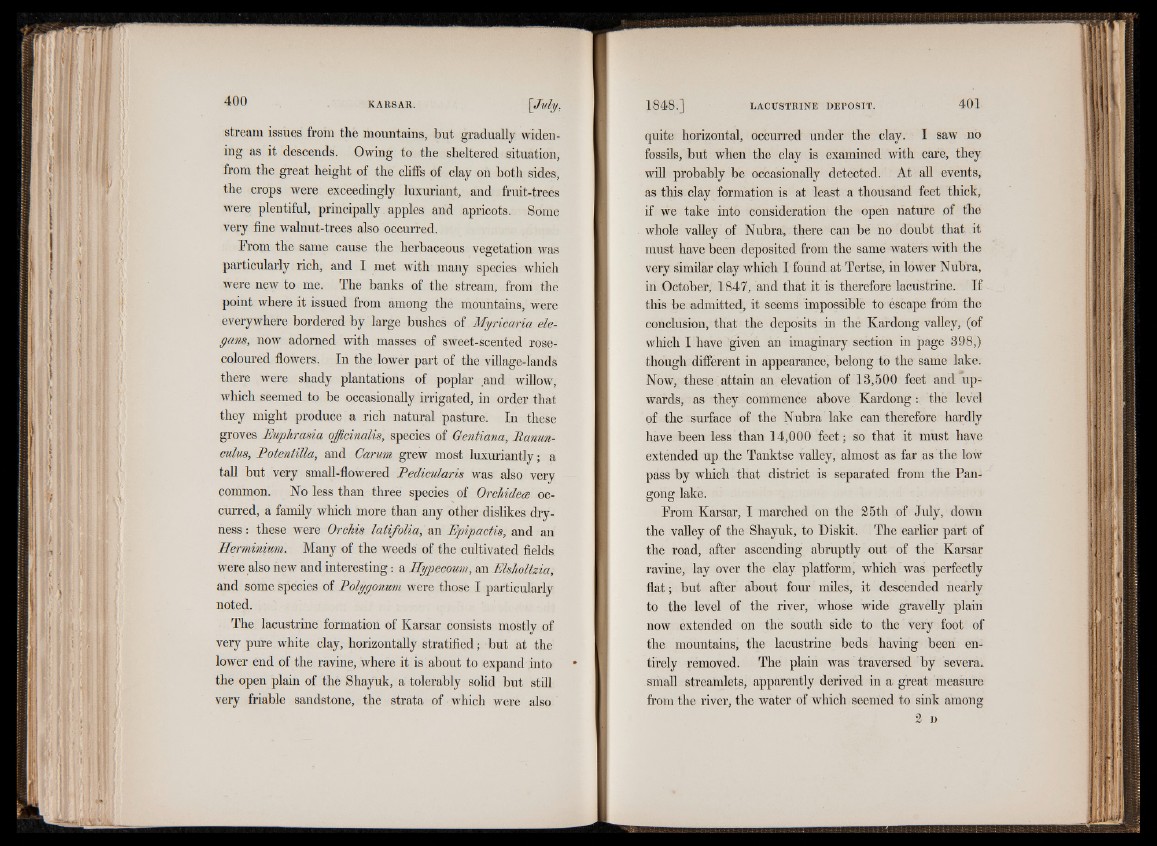
stream issues from the mountains, but gradually widening
as it descends. Owing to the sheltered situation,
from the great height of the cliffs of clay on both sides,
the crops were exceedingly luxuriant, and fruit-trees
were plentiful, principally apples and apricots. Some
very fine walnut-trees also occurred.
From the same cause the herbaceous vegetation was
particularly rich, and I met with many species which
were new to me. The banks of the stream, from the
point where it issued from among the mountains, were
everywhere bordered by large bushes of Myricaria ele-
gans, now adorned with masses of sweet-scented rose-
coloured flowers. In the lower part of the village-lands
there were shady plantations of poplar and willow,
which seemed, to be occasionally irrigated, in order that
they might produce a rich natural pasture. In these
groves Euphrasia officinalis, species of Gentiana, Ranunculus,
Potentilla, and Carum grew most luxuriantly; a
tall but very small-flowered Pedicularis was also very
common. No less than three species of Orchidece occurred,
a family which more than any other dislikes dryness
: these were Orchis latifolia, an Epipactis, and an
Herminium. Many of the weeds of the cultivated fields
were also new and interesting: a Hypecoum, an Elsholtzia,
and some species of Polygonum were those I particularly
noted.
The lacustrine formation of Karsar consists mostly of
very pure white clay, horizontally stratified; but at the
lower end of the ravine, where it is about to expand into
the open plain of the Shayuk, a tolerably solid but still
very friable sandstone, the strata of which were also
quite horizontal, occurred under the clay. I saw no
fossils, but when the clay is examined with care, they
will probably be occasionally detected. At all events,
as this clay formation is at least a thousand feet thick,
if we take into consideration the open nature of the
whole valley of Nubra, there can be no doubt that it
must have been deposited from the same waters with the
very similar clay which I found at Tertse, in lower Nubra,
in October, 1847, and that it is therefore lacustrine. If
this be admitted, it seems impossible to escape from the
conclusion, that the deposits in the Kardong valley, (of
which I have given an imaginary section in page 398,)
though different in appearance, belong to the same lake.
Now, these attain an elevation of 13,500 feet and upwards,
as they commence above Kardong: the level
of the surface of the Nubra lake can therefore hardly
have been less than 14,000 feet; so that it must have
extended up the Tanktse valley, almost as far as the low
pass by which that district is separated from the Pan-
gong lake.
From Karsar, I marched on the 25th of July, down
the valley of the Shayuk, to Diskit. The earlier part of
the road, after ascending abruptly out of the Karsar
ravine, lay over the clay platform, which was perfectly
flat; but after about four miles, it descended nearly
to the level of the river, whose wide gravelly plain
now extended on the south side to the very foot of
the mountains, the lacustrine beds having been entirely
removed. The plain was traversed by severa*
small streamlets, apparently derived in a great measure
from the river, the water of which seemed to sink among
2 D